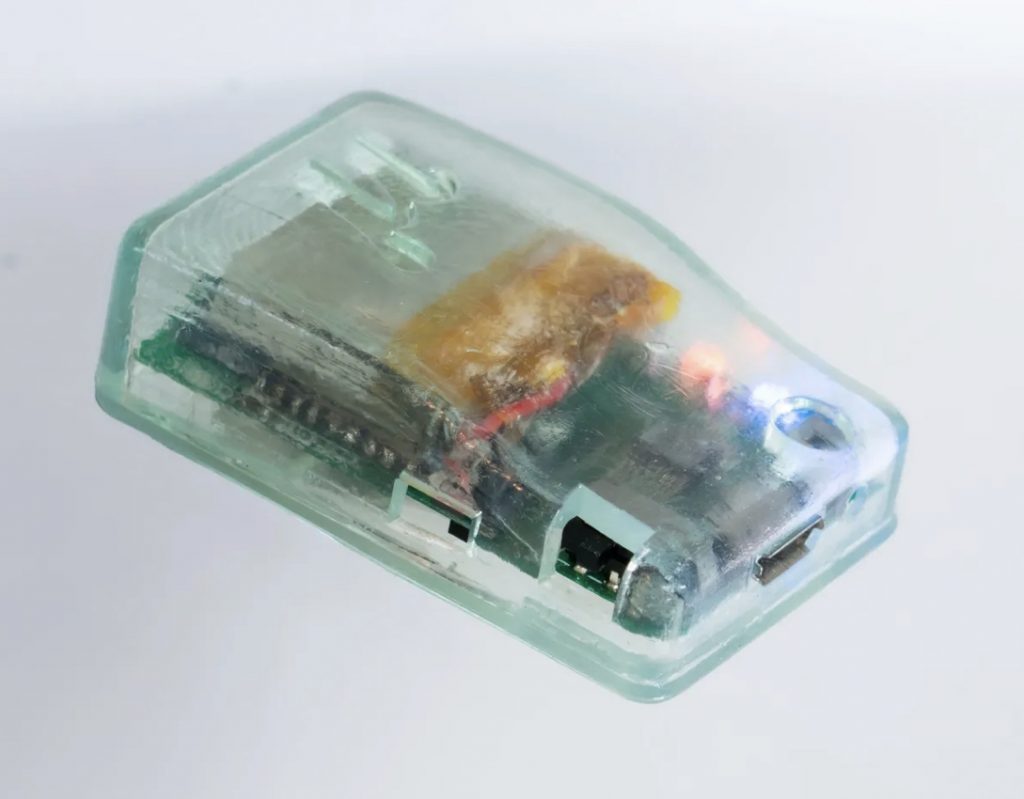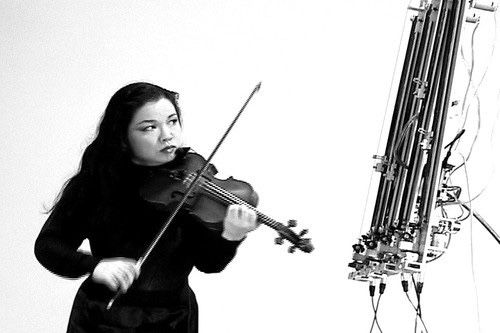To say that the Claire Trevor School of the Arts professor Mari Kimura is one-of-a-kind is an understatement. An award-winning composer, violinist and instrumentalist, Kimura’s innovative approach to sound foresees vast technological advances in the world of music. Fusing the sonic capabilities of classic, contemporary violin and improvisational, interactive computer music into a distinctive sound palette of her own, Kimura continues to radically defy the standards of music and live performance.
Having performed as a soloist with the Tokyo Philharmonic Orchestra and Tokyo Symphony Orchestra, Kimura is often lauded for her dynamic recitals and improvised life performances. Equally captivating are her premieres of notable compositions by avante-garde composers including Jean-Claude Risset, Toshi Ichiyanagi, Frances White, Tania León, Robert Rowe and Yoshihiro Kanno.
According to Kimura, her foray into the world of music came early.
“I think my earliest memory [of music] was when my mother was playing the piano, and I was on her lap, when I was two. She wanted to be a pianist in Japan … she grew up feeling envious towards her friend who played the violin, so she made me play the violin,” Kimura said.
As a student, Kimura studied violin and music composition with Mario Davidovksy, Armand & Margaret Weisbord, Toshiya Eto, Roman Totenberg and Joseph Fuchs. When composing, Kimura typically draws inspiration from life itself, yet deliberately avoids personal matters for the sake of her work.
“Anything that’s around me, my life, social conditions, anything that affects other people … I rarely do things that affect me personally, and if it does, I always code it in a way, emotionally,” Kimura said.
Arguably Kimura’s crowning glory is her specialized use of subharmonics, a technique that allows an instrument’s pitch to fall below the normal range without re-tuning. Kimura — who has been hard at work fine-tuning the subharmonic technique for more than a decade — is now able to achieve even lower intervals of sound, far below the fundamental notes of her violin.
Her subharmonic mastery is captured in her self-produced album, “The World Below G and Beyond,” a dynamic 16-track album that demands attention and rouses excitement with each tilt of the bowstring.
Despite having received plenty of awards, fellowships and residencies, Kimura approaches her recognition with modesty.
“[Awards] are important because that would open doors for me to do more. The award itself might not be that important, but it could get me somewhere: to the next stage of my work. ‘Oh my god, I won this award, oh my god’ — it’s not like that. It’s more like, ‘Oh, with this award, you can do this,’ or, you know, ‘because I have accumulated a resumé, now I can apply to this or I can go to that’… Awards and recognitions are tools, you know, they are not goals. That’s how I see it,” Kimura said.
Kimura was awarded the 1995 Kenzo Nakajima Music Prize, the 2011 Fromm Commission Award from Harvard, selected in 2010 as one of two Composers in Residence at Institut de Recherche et Coordination Acoustique/Musique (IRCAM) in Paris for music research, received the 2010 Guggenheim Fellowship award in music composition and, most recently, was given the 2014 Composers Now creative residency at the Rockefeller Brothers Fund.
Frequently the subject of notable major publications and magazines, Kimura has also been featured and reviewed in places like The New York Times, the Scientific American and The Houston Press on multiple occasions. Her 1999 recital at the Merkin Concert Hall in New York, presented by the League of Composers (ISCM), was reviewed in one Times feature, dubbing her “a virtuoso playing at the edge” of seemingly impossible technical music boundaries. In addition, Kimura was named one of 45 “Great Immigrants” in 2011 by the Carnegie Corporation. And if her repertoire of reviews and accolades isn’t impressive enough, Kimura even has her own dedicated Wikipedia entry.
As a formal educator, Kimura has a track-record for earning positions of high regard. Since 1998, Kimura has been teaching a graduate course in Interactive Computer Music Performance at The Juilliard School; Since 2013, Kimura has been the Founding Chair of the Future Music Lab at the Atlantic Music Festival (AMF), which has been developed with the purpose of providing “a transformative musical experience for musicians from all around the world.” Through one-on-one instruction, group lessons and seminars, participating musicians are given the once-in-a-lifetime opportunity to work under the tutelage of Professor Kimura. The lab in its entirety is led in official collaboration with IRCAM, and with the Integrated Composition, Improvisation and Technology (ICIT) program at UCI. The program hinges on exploring composition, improvisation, technique and contemporary music performance, all with the latest and greatest in interactive computer technology.
At UCI, chosen participants have ready access to Kimura’s very own invention, the Music/User Gesture Interface Control (MUGIC) motion tracking sensor. MUGIC is an innovative hand-operative device that captures the user’s movements, of which can then be used to control parameters in computer music and sound design.


After having led a combined body of computer science, electrical engineering, mechanical engineering and music department students from UCI and developing a proprietary prototype of the device for two years, Kimura’s MUGIC became available for commercial use in September of 2020.
Though her history with UC Irvine is relatively brief, Kimura’s rich, professional experience as both student and mentor has earned her the Professor of Music title at UCI’s Integrated Composition, Improvisation and Technology (ICIT) Ph. D. program. In conjunction with Kimura and other members of a core faculty, the program seeks to challenge conventional standards of music, composition and performance, by applying creative, subversive approaches to contemporary music-making. In addition, Professor Kimura is the instructor of the school’s graduate seminar “Composing with Sensors,” which actively incorporates MUGIC into its curriculum. Kimura’s graduate students even apply MUGIC in their own vested interests, typically in performing and composing music. Concurrently, Kimura also organizes “Listen to the Motion” festivals on campus, often featuring ICIT students’ own compositions and work with MUGIC.
When asked about her transition from student to teacher, Kimura explains that learning and teaching are two sides of the same coin.
“I always say that teaching is actually learning. You teach and you learn. I get so much out of my students because I learn from being a teacher, so it doesn’t really make much of a difference for me, because when I’m teaching I’m basically sharing what I know, right?” Kimura said.
After all, Kimura still finds solace in her academic endeavors, most recently in her experience as an educator.
“In a cliché answer, the benefit of being a professor is that I get to connect with a younger generation, whose outlook is different from mine because [they] grew up in a different time … That is something that I cannot experience myself,” Kimura said.
Kimura appreciates a difference in perspectives; to her, getting to interact with students is a breath of fresh air.
“It’s a different world, different time and a different culture for me.”
Kimura also speaks candidly on the role her students have played in her learning curve as a long-time professor.
“I am still very interested in what my students are experiencing or feeling because of their headspace. What you’re thinking, how you’re finding the world, it’s something that I can learn from. That’s why being a professor is a great thing,” Kimura said.
The vast sum of her work, both as a professor and experimental composer, speaks volumes about Kimura’s ability to succeed in all aspects of life — from the vast exploration of music to the structured rigor of academia. A violin visionary with a penchant for boundary-pushing, Kimura’s creative talent lies far beyond the instrument’s natural sonic capabilities. Her latest release, “Mari Kimura, Milica Paranosic & Others: Music for Violin & Electronics” is available on streaming services everywhere, and features the likes of Jean-Claude Risset, Conlon Nancarrow and Tania Léon, among others.
Mia Hammett is an Entertainment staff writer. She can be reached at hammettm@uci.edu.


